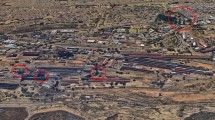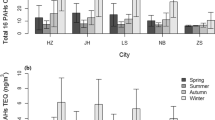Abstract
In this study, ambient PM2.5 samples were collected from October 2014 to August 2015 in urban area of Luoyang (LY) and Pingdingshan (PDS), two medium-size industrial cities in central China. Sixteen priority polycyclic aromatic hydrocarbons (PAHs) were analyzed to investigate the seasonal variation, potential pollution sources, and health risk of PAHs bound to PM2.5 (PM2.5-bound PAHs). The diagnostic ratios analysis and positive matrix fraction (PMF) model were used to identify potential sources of PM2.5-bound PAHs. The annual average concentrations of PM2.5 and PM2.5-bound PAHs were 128 μg m−3 and 73 ng m−3 for LY, and 119 μg m−3 and 182 ng m−3 for PDS, respectively, both displaying seasonal trends with higher concentrations in winter and autumn than in spring and summer. BaP equivalent concentrations were 14.4 and 16.5 ng m−3 in LY and PDS, respectively. The predominant PAHs were 4–6 ring PAHs, with contribution of more than 80% at both sampling sites. PMF analysis revealed that coal combustion was the most important source of PM2.5-bound PAHs in LY and PDS, accounting for 37% and 39%, respectively, followed by traffic emissions (34% and 33% in LY and PDS, respectively). The average inhalation cancer risk (ICR) for a lifetime of 70 years were 12.5 × 10−4 and 14.3 × 10−4 in LY and PDS, respectively, which were much higher than US EPA guideline limit of 10−6. The traffic source and coal combustion source contributed the highest ICR values in LY and PDS, respectively.







Similar content being viewed by others
References
Bandowe BAM, Meusel H, Huang R, Ho K, Cao J, Hoffmann T, Wilcke W (2014) PM2.5-bound oxygenated PAHs, nitro-PAHs and parent-PAHs from the atmosphere of a Chinese megacity: seasonal variation, sources and cancer risk assessment. Sci Total Environ 473–474:77–87. https://doi.org/10.1016/j.scitotenv.2013.11.108
Bourotte C, Forti M, Taniguchi S, Bícego MC, Lotufo PA (2005) A wintertime study of PAHs in fine and coarse aerosols in São Paulo city, Brazil. Atmos Environ 39:3799–3811. https://doi.org/10.1016/j.atmosenv.2005.02.054
Brown SG, Eberly S, Paatero P, Norris GA (2015) Methods for estimating uncertainty in PMF solutions: examples with ambient air and water quality data and guidance on reporting PMF results. Sci Total Environ 518–519:626–635. https://doi.org/10.1016/j.scitotenv.2015.01.022
Burnett RT, Pope CA III, Ezzati M et al (2014) An integrated risk function for estimating the global burden of disease attributable to ambient fine particulate matter exposure. Environ Health Perspect 122:397–403. https://doi.org/10.1289/ehp.1307049
Callén MS, Iturmendi A, López JM (2014) Source apportionment of atmospheric PM2.5-bound polycyclic aromatic hydrocarbons by a PMF receptor model. Assessment of potential risk for human health. Environ Pollut 195:167–177. https://doi.org/10.1016/j.envpol.2014.08.025
Chen YC, Chiang HC, Hsu CY et al (2016) Ambient PM2.5-bound polycyclic aromatic hydrocarbons (PAHs) in Changhua County, central Taiwan: Seasonal variation, source apportionment and cancer risk assessment. Environ Pollut 218:372–382. https://doi.org/10.1016/j.envpol.2016.07.016
Feng J, Yu H, Su X, Liu S, Li Y, Pan Y, Sun J (2016) Chemical composition and source apportionment of PM2.5 during Chinese Spring Festival at Xinxiang, a heavily polluted city in North China: fireworks and health risks. Atmos Res 182:176–188. https://doi.org/10.1016/j.atmosres.2016.07.028
Feng B, Li L, Xu H et al (2019) PM2.5-bound polycyclic aromatic hydrocarbons (PAHs) in Beijing: seasonal variations, sources, and risk assessment. J Environ Sci China 77:11–19. https://doi.org/10.1016/j.jes.2017.12.025
Kim K, Jahan SA, Kabir E, Brown RJC (2013) A review of airborne polycyclic aromatic hydrocarbons (PAHs) and their human health effects. Environ Int 60:71–80. https://doi.org/10.1016/j.envint.2013.07.019
Kong S, Ding X, Bai Z, Han B, Chen L, Shi J, Li Z (2010) A seasonal study of polycyclic aromatic hydrocarbons in PM2.5 and PM2.5-10 in five typical cities of Liaoning Province, China. J Hazard Mater 183:70–80. https://doi.org/10.1016/j.jhazmat.2010.06.107
Kong S, Shi J, Lu B et al (2011) Characterization of PAHs within PM10 fraction for ashes from coke production, iron smelt, heating station and power plant stacks in Liaoning Province, China. Atmos Environ 45:3777–3785. https://doi.org/10.1016/j.atmosenv.2011.04.029
Kong S, Ji Y, Li Z, Lu B, Bai Z (2013) Emission and profile characteristic of polycyclic aromatic hydrocarbons in PM2.5 and PM10 from stationary sources based on dilution sampling. Atmos Environ 77:155–165. https://doi.org/10.1016/j.atmosenv.2013.04.073
Kulkarni P, Venkataraman C (2000) Atmospheric polycyclic aromatic hydrocarbons in Mumbai. India Atmos Environ 34:2785–2790. https://doi.org/10.1016/S1352-2310(99)00312-X
Lelieveld J, Evans JS, Fnais M, Giannadaki D, Pozzer A (2015) The contribution of outdoor air pollution sources to premature mortality on a global scale. Nature 525:367–371. https://doi.org/10.1038/nature15371
Li Z, Porter EN, Sjödin A, Needham LL, Lee S, Russell AG, Mulholland JA (2009) Characterization of PM2.5-bound polycyclic aromatic hydrocarbons in Atlanta–Seasonal variations at urban, suburban, and rural ambient air monitoring sites. Atmos Environ 43:4187–4193. https://doi.org/10.1016/j.atmosenv.2009.05.031
Liu J, Man R, Ma S, Li J, Wu Q, Peng J (2015) Atmospheric levels and health risk of polycyclic aromatic hydrocarbons (PAHs) bound to PM2.5 in Guangzhou, China. Mar Pollut Bull 100:134–143. https://doi.org/10.1016/j.marpolbul.2015.09.014
Ma W, Li Y, Qi H, Sun D, Liu L, Wang D (2010) Seasonal variations of sources of polycyclic aromatic hydrocarbons (PAHs) to a northeastern urban city, China. Chemosphere 79:441–447. https://doi.org/10.1016/j.chemosphere.2010.01.048
Manousakas M, Papaefthymiou H, Diapouli E, Migliori A, Karydas AG, Bogdanovic-Radovic I, Eleftheriadis K (2017) Assessment of PM2.5 sources and their corresponding level of uncertainty in a coastal urban area using EPA PMF 5.0 enhanced diagnostics. Sci Total Environ 574:155–164. https://doi.org/10.1016/j.scitotenv.2016.09.047
Mu L, Peng L, Liu X et al (2014) Characteristics of polycyclic aromatic hydrocarbons and their gas/particle partitioning from fugitive emissions in coke plants. Atmos Environ 83:202–210. https://doi.org/10.1016/j.atmosenv.2013.09.043
Nisbet ICT, Lagoy PK (1992) Toxic equivalency factors (TEFs) for polycyclic aromatic hydrocarbons (PAHs). Regul Toxicol Pharm 16:290–300. https://doi.org/10.1016/0273-2300(92)90009-X
OEHHA (2003) The air toxics hot spots program guidance manual for preparation of health risk assessments. California Environmental Protection Agency, Office of Environmental Health Hazard Assessment, Oakland, CA. https://oehha.ca.gov/media/downloads/crnr/hrafinalnoapp.pdf. Accessed 1 Oct 2018
Paatero P (1997) Least squares formulation of robust non-negative factor analysis. Chemometr Intell Lab Syst 37:23–35. https://doi.org/10.1016/S0169-7439(96)00044-5
Paatero P, Tapper U (1994) Positive matrix factorization: a non-negative factor model with optimal utilization of error estimates of data values. Environmetrics 5:111–126. https://doi.org/10.1002/env.3170050203
Paatero P, Eberly S, Brown SG, Norris GA (2014) Methods for estimating uncertainty in factor analytic solutions. Atmos Meas Tech 7:781–797. https://doi.org/10.5194/amt-7-781-2014
Peng C, Chen W, Liao X, Wang M, Ouyang Z, Jiao W, Bai Y (2011) Polycyclic aromatic hydrocarbons in urban soils of Beijing: status, sources, distribution and potential risk. Environ Pollut 159:802–808. https://doi.org/10.1016/j.envpol.2010.11.003
Qiu P, Tian H, Zhu C, Liu K, Gao J, Zhou J (2014) An elaborate high resolution emission inventory of primary air pollutants for the Central Plain Urban Agglomeration of China. Atmos Environ 86:93–101. https://doi.org/10.1016/j.atmosenv.2013.11.062
Ravindra K, Sokhi R, Vangrieken R (2008) Atmospheric polycyclic aromatic hydrocarbons: source attribution, emission factors and regulation. Atmos Environ 42:2895–2921. https://doi.org/10.1016/j.atmosenv.2007.12.010
Schauer JJ, Kleeman MJ, Cass GR et al (2002) Measurement of emissions from air pollution sources. 5. C1-C32 organic compounds from gasoline-powered motor vehicles. Environ Sci Technol. https://doi.org/10.1021/es0108077
Shi GL, Zhou XY, Jiang SY et al (2015) Further insights into the composition, source, and toxicity of PAHs in size-resolved particulate matter in a megacity in China. Environ Toxicol Chem 34:480–487. https://doi.org/10.1002/etc.2809
Teixeira EC, Agudelo-Castañeda DM, Mattiuzi CDP (2015) Contribution of polycyclic aromatic hydrocarbon (PAH) sources to the urban environment: a comparison of receptor models. Sci Total Environ 538:212–219. https://doi.org/10.1016/j.scitotenv.2015.07.072
Tham YWF, Takeda K, Sakugawa H (2008) Polycyclic aromatic hydrocarbons (PAHs) associated with atmospheric particles in Higashi Hiroshima, Japan: influence of meteorological conditions and seasonal variations. Atmos Res 88:224–233. https://doi.org/10.1016/j.atmosres.2007.10.015
Tobiszewski M, Namieśnik J (2012) PAH diagnostic ratios for the identification of pollution emission sources. Environ Pollut 162:110–119. https://doi.org/10.1016/j.envpol.2011.10.025
USEPA (2014) EPA positive matrix factorization (PMF) 5.0 fundamentals and user guide. Office of Research and Development, Washington, DC. https://www.epa.gov/sites/production/files/2015-02/documents/pmf_5.0_user_guide.pdf. Accessed 10 Aug 2018
Wang G, Huang L, Zhao X, Niu H, Dai Z (2006) Aliphatic and polycyclic aromatic hydrocarbons of atmospheric aerosols in five locations of Nanjing urban area, China. Atmos Res 81:54–66. https://doi.org/10.1016/j.atmosres.2005.11.004
Wang F, Lin T, Feng J, Fu H, Guo Z (2015a) Source apportionment of polycyclic aromatic hydrocarbons in PM2.5 using positive matrix factorization modeling in Shanghai, China. Environ Sci Processes Impacts 17:197–205. https://doi.org/10.1039/C4EM00570H
Wang J, Li X, Jiang N, Zhang W, Zhang R, Tang X (2015b) Long term observations of PM2.5-associated PAHs: comparisons between normal and episode days. Atmos Environ 104:228–236. https://doi.org/10.1016/j.atmosenv.2015.01.026
Wang Q, Liu M, Yu Y, Li Y (2016) Characterization and source apportionment of PM2.5-bound polycyclic aromatic hydrocarbons from Shanghai city, China. Environ Pollut 218:118–128. https://doi.org/10.1016/j.envpol.2016.08.037
Wang Q, Jiang N, Yin S, Li X, Yu F, Guo Y, Zhang R (2017) Carbonaceous species in PM2.5 and PM10 in urban area of Zhengzhou in China: Seasonal variations and source apportionment. Atmos Res 191:1–11. https://doi.org/10.1016/j.atmosres.2017.02.003
Wongphatarakul V, Friedlander SK, Pinto JP (1998) A comparative study of PM2.5 ambient aerosol chemical databases. Environ Sci Technol 32:3926–3934
World Health Organization (2000) The world health report 2000-health systems: improving performance. http://www.hoint/whr/2000/en/. Accessed 1 May 2018
Xiong Q, Zhao W, Gong Z, Zhao W, Tang T (2015) Fine particulate matter pollution and hospital admissions for respiratory diseases in Beijing, China. Int J Environ Res Pub He 12:11880–11892. https://doi.org/10.3390/ijerph120911880
Yan Y, He Q, Guo L, Li H, Zhang H, Shao M, Wang Y (2017) Source apportionment and toxicity of atmospheric polycyclic aromatic hydrocarbons by PMF: quantifying the influence of coal usage in Taiyuan, China. Atmos Res 193:50–59. https://doi.org/10.1016/j.atmosres.2017.04.001
Yin H, Xu L (2018) Comparative study of PM10/PM2.5-bound PAHs in downtown Beijing, China: concentrations, sources, and health risks. J Clean Prod 177:674–683. https://doi.org/10.1016/j.jclepro.2017.12.263
Yunker MB, Macdonald RW, Vingarzan R, Mitchell RH, Goyette D, Sylvestre S (2002) PAHs in the Fraser River basin: a critical appraisal of PAH ratios as indicators of PAH source and composition. Org Geochem 33:489–515. https://doi.org/10.1016/S0146-6380(02)00002-5
Zhang Y, Tao S (2009) Global atmospheric emission inventory of polycyclic aromatic hydrocarbons (PAHs) for 2004. Atmos Environ 43:812–819. https://doi.org/10.1016/j.atmosenv.2008.10.050
Zhang Q, Quan J, Tie X, Li X, Liu Q, Gao Y, Zhao D (2015) Effects of meteorology and secondary particle formation on visibility during heavy haze events in Beijing, China. Sci Total Environ 502:578–584. https://doi.org/10.1016/j.scitotenv.2014.09.079
Zheng X, Wu Y, Zhang S et al (2017) Characterizing particulate polycyclic aromatic hydrocarbon emissions from diesel vehicles using a portable emissions measurement system. Sci Rep. https://doi.org/10.1038/s41598-017-09822-w
Acknowledgments
This study is supported by Central Leading Local Development of Scientific and Technology Project in China (Grant No. HN 2016-149). The authors thank those assisting in analyses: Shenbo Wang, Shijie Yu, Qiang Li, and Xue Yu. The first author acknowledges the support of China Scholarship council (No. 201707040082).
Author information
Authors and Affiliations
Corresponding author
Electronic supplementary material
Below is the link to the electronic supplementary material.
Rights and permissions
About this article
Cite this article
Wang, Q., Dong, Z., Guo, Y. et al. Characterization of PM2.5-Bound Polycyclic Aromatic Hydrocarbons at Two Central China Cities: Seasonal Variation, Sources, and Health Risk Assessment. Arch Environ Contam Toxicol 78, 20–33 (2020). https://doi.org/10.1007/s00244-019-00671-4
Received:
Accepted:
Published:
Issue Date:
DOI: https://doi.org/10.1007/s00244-019-00671-4




